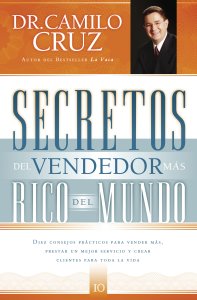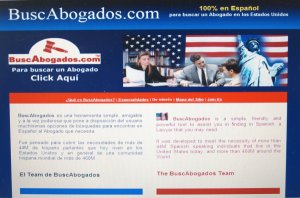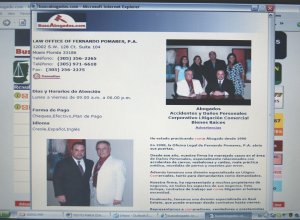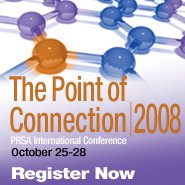Posted by Elena del Valle on July 11, 2008

Secretos del Vendedor Más Rico del Mundo book cover
(Successful Secrets From the Wealthiest Salesman in the World)
Photos: Grupo Nelson
Entrepreneur and speaker Camilo Cruz, Ph.D. believes everyone is a salesman and he sets out to explain his secrets of selling in his new Spanish language book Secretos del Vendedor Más Rico del Mundo (Successful Secrets From the Wealthiest Salesman in the World). Although the book was written with salesmen in mind, promotional materials promise it contains universal concepts applicable for achieving success in any area of life.
On the cover of his ambitiously titled soft cover 204-page book, Cruz promises 10 practical tips to sell better, offer better service and create clients for life. Published by Grupo Nelson, a division of Thomas Nelson Publishers, the book sells for $14.99.
“We are all salespeople! Whether we are aware of it or not, we are constantly selling something,” said Cruz who has a Ph.D. in chemistry from Seton Hall University. “Entrepreneurs sharing business opportunities with others, parents persuading their children to adopt the proper values and principles to be successful in life, professionals offering their skills and talents-they are all selling.”

Author Camilo Cruz, Ph.D.
“Segmentation by Level of Acculturation” audio recording

Presenter Miguel Gomez Winebrenner
Discusses
- Assimilation versus acculturation
- Factors that affect Latino acculturation
- How to know if someone is acculturated
- Number of years necessary for acculturation
- Effects of immigration debate on acculturation
- Three main ways of segmenting Latinos
Click here for details about “Segmentation by Level of Acculturation”
He relies on the idea that selling is more than a presentation of products; instead he believes it has to do with the way people communicate their ideas, offer their services or introduce their talents and professional skills to prospects.Cruz has had 26 books published with combined sales of more than a million copies. His book, La Vaca (Once Upon a Cow), also written in Spanish, was translated into more than twelve languages.
Cruz has launched three companies. He co-founded Yupi Internet, a Spanish-language portal acquired by Microsoft. He is the founder of Taller del Éxito Group, a training and motivational company based in Latin America, and ElExito.com, a self-improvement portal for Spanish speaking Latinos.

Click here to buy Secretos del vendedor mas rico del mundo
Comments:
Filed Under: Books
Posted by Elena del Valle on July 10, 2008

Photo: Simon & Baker
Latino labor growth has slowed down due to America’s economic woes and the construction industry recession, and working age immigrant Latinos represent a lesser percent of the overall Hispanic labor pool than in the recent past. These are the findings of a recent Pew Hispanic Center report on labor and Latinos trends in the United States.
In spite in the decreasing growth opportunities, there are no indications that immigrant Latino workers are leaving the country, according to Latino Labor Report, 2008 written by Rakesh Kochhar, associate director for Research, Pew Hispanic Center. Latinos represent 14 percent of the United States labor pool and more than half, 52 percent, of working age Latinos are immigrants.
Target Latinos effectively by anticipating changes in the market with
“Hispanic Projections with 2007-08 update” audio recording

Presenter Roger Selbert, Ph.D.
Find out
- About Latino buying power growth in the future
- How Latino market growth compares with other markets in the U.S.
- What drives the rise of Latino economic clout
- Who should target the Latino market
- What is the size of the Hispanic affluent market
- If the luxury Latino market is growing
Stay ahead of your competition with “Hispanic Projections”
As a result changes in the Latino working population may have a limited impact on the overall working population. Nonetheless, it is noteworthy that Hispanic unemployment in the first quarter of 2008 was much higher than non Hispanic employment, 6.5 percent versus 4.7 percent. This data is in marked contrast with labor statistics of less than two years ago.
In late 2006 the difference in unemployment between Latinos and the mainstream was only .5 percent, 4.9 percent for Latinos compared to 4.5 percent for non Latinos. Immigrant workers have been affected more than most. For example, for the first time in five years more foreign more born Latinos than native born Latinos were unemployed.
In the last year, changes in the construction industry caused a drop of 250,000 jobs among Latinos and eliminated existing job growth within that working group. This is significant because for years construction represented the largest growth industry for Hispanic workers, especially among immigrants. Of the 221,000 Latino workers who left jobs in construction last year, 152,000 were people who had migrated from Mexico.
In 2007, Latino women suffered in greater numbers than their male counterparts, leaving the labor force in great proportion and showing more unemployment than Latino men. There were 130,000 Latino women who became unemployed last year and unemployment among Latino women increased from 5.6 percent to 7 percent.
The report was based on the Pew Hispanic Center’s analysis of recent Bureau of Labor Statistics and Census Bureau data, mainly the Current Population Survey. The Pew Hispanic Center, an initiative of the Pew Research Center, is a non-partisan, non-advocacy research organization based in Washington, D.C. The Pew Hispanic Center is funded by The Pew Charitable Trusts.
Hispanic Marketing and Public Relations Understanding and Targeting America’s Largest Minority book

“A must resource for practitioners/professionals expecting to reach US Hispanics; also valuable for college programs in marketing, public relations and communications. Highly recommended.”
Choice magazine
Click here for information on the Hispanic Marketing & Public Relations books
Posted by Elena del Valle on July 9, 2008
Information provided by our Event Partner

November 13-14, 2008
Sofitel, Los Angeles, CA
The Hollywood Reporter and Billboard join forces to deliver a cutting-edge, two-day seminar on the role of music in film and television. The 7th annual event provides a dynamic forum for the exchange of ideas among film, TV and music professionals. Also featured will be live artist performances, roundtable discussions, and networking cocktail parties
Program highlights:
• Anatomy of a film – The process of deconstructing a
blockbuster film and the creative process used in uniting
audio with visual.
• Director/Composer Line – A spirited exploration of the
magical synergy between filmmaker and composer.
• Master Class – Hear about selecting the right artists,
negotiating 360 deals, launching labels and publishing
companies, to writing and performing songs.
• The Secrets Behind Video Game Music, Trailer Songs & Underscore, Film Composition and TV Music
• Live song critiques from the experts
• Roundtable workshops on hot industry topics
• Invaluable Networking opportunities with industry influencers
For more information on the event visit: http://www.billboardevents.com/billboardevents/filmtv/index.jsp
HispanicMPR members receive a special rate with promo code
MPR325. Questions? email Brittany.davies@nielsen.com or call 646-654-5883
Posted by Elena del Valle on July 9, 2008

Tecate Light store floor ad
Photo, video: Tecate Light
Mexican beer maker Fomento Economico Mexicano, S.A. de C.V. (FEMSA) and Heineken USA, importers of Tecate Light, hope to attract acculturated Mexicans and Mexican-American adults in the United States with a newly released two-language multimedia ad campaign. The brand’s first dual-language ad campaign was launched June 30, 2008 in general market and Spanish language media outlets and will run through the end of 2008. Scroll down to watch a Tecate Light video ad.
The ad makes up two distinct executions under the same tag line, “Para los que quieren más,” Spanish for “For those who want more.” The English-language ads invite Mexican-American men to “break the habit” of drinking less-flavorful light beers in favor of Tecate Light.
To achieve this, two separate 30-second TV spots present men acting out their favorite guilty pleasures, such as watching telenovelas (Spanish language soap operas) and talking loudly on their cell phone, while drinking a generic light beer. In each spot, Marco Uriel, a Mexican actor chastises men for their bad beer drinking habits and invites them to try Tecate Light beer.
Make your ads resonate with Hispanics
Listen to C&R’s Research Director Liria Barbosa in
“Hispanics’ Perspective on Advertising” audio recording

Liria Barbosa gives a presentation and participates in an extended Q&A discussion about
• Type of ads Latinos prefer
• Latino top media choices
• Percent of Latinos who tried products because of ads
• Percent of Latinos who purchased products because of ads
• What makes an ad “Hispanic”
• If ad language is important for bicultural Latinos
• What to keep in mind when targeting bicultural Latinos with ads
Click here for information on Hispanic Perspectives on Advertising
The Spanish-language Tecate Light campaign plays off the concept that Mexican men in the United States shouldn’t have to settle for a less flavorful beer than what they’re used to. The “Papás” 30 second TV spot features distraught Mexican parents who share a testimonial to their adult son in the United States and their disappointment in his choice of light, flavorless beers.
“As the most popular light cerveza in Mexico, we believe it’s important to converse with our consumers in the language that they feel most comfortable. With the continued growth of the U.S. Hispanic population, and especially the second and third generation Mexican-Americans populations, we wanted to create a campaign that addresses their intrinsic yearning for more flavor in their beer,” said Carlos Boughton, brand director for Tecate and Tecate Light.

Carlos Boughton, brand director, Tecate and Tecate Light
The spots in Spanish will air in Tucson, Albuquerque and San Antonio while the two 30-second TV spots in English will air on ABC, CBS, FOX and NBC; as well as several cable channels including ESPN, History Channel, and Discovery Channel. Additionally, the Spanish-language counterpart ads will be seen on Univision, Telemundo and Telefutura throughout the 20 markets where Tecate Light is available. Print ads will run in the July issue of Maxim en Español. There will also be radio, out-of-home and point of sale components to the campaign.
The campaign work is divided between three agencies: the creative concept was developed by Adrenalina; MediaVest New York will place the ads; and Formula PR will handle public relations efforts to support the campaign.
“According to Census figures, the largest growth segment of the Hispanic population is not immigrants, but the children of immigrants who tend to be different beyond simply the language they speak,” said Manuel Wernicky, founder and principal of Adrenalina. “This is an innovative campaign because we recognized that there are two different types of consumers of Mexican descent, which is why we created two unique campaigns under one brand platform instead of simply translating the same work in English and Spanish. This is not a one-size-fits-all campaign.”
“Best in Class Hispanic Strategies” audio recording


Presenters Carlos Santiago and Derene Allen
-
Find out what makes 25 percent of the top 500 Hispanic market advertisers out perform the remaining companies
-
Discover what questions to ask, steps to take to be a Best in Class company
Click here for more about “Best in Class Hispanic Strategies” audio recording
Since 2004, as part of an agreement with FEMSA Cerveza, Heineken USA is the exclusive importer, marketer and seller of FEMSA’s beer brands in the United States. Heineken USA handles the marketing, sales and distribution of Dos Equis, Tecate, Sol, Carta Blanca, Bohemia and the new Tecate Light.
Headquartered in White Plains, New York, Heineken USA Inc. is a beer importer and a subsidiary of Heineken International B.V., a Netherlands company. Heineken USA also imports Heineken Lager, Heineken Premium Light, Heineken Dark Lager, Amstel Light, and Buckler non-alcoholic brew.
Founded in 1890, FEMSA is one of the largest integrated beverage companies in Latin America. Its subsidiary FEMSA Cerveza is one of the leading brewers in Mexico with brands that include Tecate, Dos Equis and Sol.
Posted by Elena del Valle on July 8, 2008

BuscAbogados.com – click on image to enlarge
Photos: BuscAbogados.com
In May 2008, BGB Holding Group Corp launched BuscAbogados.com (Spanish look for a lawyer), a new website in Spanish for adults in the United States, Latin America and Spain, who have access to the Internet and are seeking the services of a United States attorney. It took two years of development work to design the website as a bilingual search engine able to recognize key search words in Spanish and English.
The newly launched website lists 7,000 Florida attorneys. BuscAbogados relies on seven employees in the United States and 50 in Argentina. In addition to English and Spanish press releases, company representatives are promoting the website with printed promotional materials distributed in markets with large Hispanic populations as well as advertising in Miami area Hispanic publications.
“How to Use Your Energy to Attract Clients and Customers” audio recording

Presenter Heather Dominick, owner, EnergyRich Coaching, Inc.
A 106-minute audio recording including a presentation by Heather and the complete interview with Heather where she discusses:
- Heather’s step by step system for women entrepreneurs
- Her coaching philosophy that an individual needs to be business at a holistic level
- Core beliefs about creating magnificent marketing for your business
- How Heather transitioned from a high school drama teacher to a coach
- The three Os that characterized her life at the time
- Heather’s first steps to changing her life
Click here for information on How to Use Your Energy to Attract Clients and Customers
Ready to buy? Select a format to add to your shopping cart:
Downloadable “ How to Use Your Energy to Attract Clients and Customers ” MP3 $119.95
Audio CD’s “How to Use Your Energy to Attract Clients and Customers ” $139.95
BuscAbogados.com marketers have concentrated their efforts on website optimization in the hope of positioning the portal among the most important Internet search engines, as well as regionally-focused search engines in Latin America where they believe their services will also be of interest.

Luis Bregni, president, BuscAbogados.com
“We’re excited to be able to help the growing Hispanic market find the lawyers they need, and feel the Internet is our best medium for doing so,” said Luis Bregni, president and owner of BuscAbogados.com. “The Internet is actually more than perfect; it’s where millions of people first turn to for finding restaurants, jobs and even medical advice. So, why not give lawyers their own spot on the World Wide Web in this niche market and, at the same time, open up an easy avenue for the online Hispanic user to search for a lawyer.”

Click on image to enlarge
The website allows visitors to browse free and invites law firms to place ads for a monthly fee. For example, the $39 Standard Package offers law firms a listing with a photo and a 500-word description. There are also Professional, Premium and Platinum packages.
Bregni, originally from Argentina, has 25 years of experience working with Argentine banks and other financial institutions. He holds a degree in Economic Sciences from the University of Buenos Aires and is director of Grupo NOP in Argentina.
Two other executives, Erwin Diaz-Solis and Julio Stieffel, are listed on the BuscAbogado pages in addition to Bregni. Diaz-Solis specializes in immigration law and is a graduate of Nova Southeastern University in Fort Lauderdale, Florida. Stieffel, a graduate of the University of Miami, founded Americas Rep International, an international consulting firm specializing in the Latin American market. BuscAbogados.com, a Miami Springs company, is managed by BGB Holding Group Corp., Grupo NOP Argentina’s North America division.
Hispanic Marketing and Public Relations Understanding and Targeting America’s Largest Minority book

“A must resource for practitioners/professionals expecting to reach US Hispanics; also valuable for college programs in marketing, public relations and communications. Highly recommended.”
Choice magazine
Click here for information on the Hispanic Marketing & Public Relations books
Posted by Elena del Valle on July 7, 2008

The Pinker Tones Wild Animals album cover
Photo, song: Nacional Records
The Pinker Tones, a Barcelona musical duo known for their electronic sounds, released a new album in early June 2008. Wild Animals, the band’s third album in the United States, was released right before the beginning of their Vans Warped Tour with more than 40 venues across the United States. The two previous albums released in the United States are The Million Colour Revolution and 2007 remix album More Colours! Scroll down to watch a music video and listen to a song from the new album.
“Our last album, The Million Colour Revolution, was about utopia, a projection for how we wanted the world to be,” said Mister Furia. “Wild Animals is about reality, our interpretation of the actual world we live in. Songs like The Whistling Song, 24 and On Se Promenait are some of our happiest and most nostalgic yet.”
Wild Animals features special vocal guests including reggae soul performer Jimmy Lindsay from Cymande on The Whistling Song, and Amparo from Spanish band Amparanoia on Electrotumbao. The first single was the track Happy Everywhere.
“Moving Beyond Traditional Media Measurement: measuring conversations and social media” audio recording

Presenter Katie Delahaye Paine, founder, KDPaine & Partners
Find out about
- Issues affecting online public relationships today
- Testing relationships as part of a survey
- Measuring ethnic group relationships
- Measuring foreign language communications in a similar ways to English
- Biggest challenges measuring conversations and social media
- Measuring online relationships with little or no money
Click here for information on “Moving Beyond Traditional Media Measurement”

The Pinker Tones
Mister Furia and Professor Manso are the artistic names of the musicians that make up The Pinker Tones. In 2007, the band was featured in The New York Times, was in an A&E television special, performed on KCRW’s Morning Becomes Eclectic program, had a song featured on the TV sitcoms Ugly Betty and Entourage, and had video play on mtvU, MTV Tr3s, Mun2, and LATV.
The Pinker Tones also made an appearance at last year’s SXSW, where they performed five shows in 36 hours and at KCRW’s Sounds Eclectic Evening in Los Angeles. The Pinker Tones recent single Karma Hunters was selected by Mun2 as the theme song for Chicas Project, a reality show.
Salvador Rey, Mister Furia, performs on vocals, guitar, keyboards and flute while Alex Llovet, Professor Manso, performs on keyboards, samples and drums. They met in college in the late 1990s and formed the Pinker Tones in 2001.
Click on the play button to watch the music video Happy Everywhere.

Click here to buy Wild Animals CD
CD
Posted by Elena del Valle on July 3, 2008
Information provided by our Event Partner

5th Annual Multicultural Marketing Summit
October 22-24, 2008
Miami, FL
Discover New Growth Opportunities within the Multicultural Markets
The 5th Annual Multicultural Marketing Summit will showcase solutions from Fortune 1000 companies that are successfully targeting multicultural audiences. The Summit is hosted by Latin Force Group, LLC and will take place October 22-24, 2008 at the Mandarin Oriental Hotel in Miami, Florida.
The Summit is a standout, five-star event, highly rated by participants for the quality of its agenda and speakers. The sophisticated ambiance of the Mandarin Oriental hotel creates an elegant atmosphere where senior executives can network and learn from peers about the latest in market intelligence, case studies and best practices across numerous industries. Firms will provide examples on how repositioning their companies within multicultural markets contributed significantly to increased revenue and profits. The Summit will feature case studies presented by top level executives from Fortune 1000 companies such as Goldman Sachs, Mass Mutual, Humana, Inc., and Coors Brewing Company. Presenters and attendees from past years include executives from leading companies such as Nationwide Insurance, Toyota Financial Services, General Mills, Univision, and much more.
A favorite feature of the Summit is the live musical entertainment each night. This year, attendees will be treated to a special performance by The Island Def Jam Music Group’s break out artist, Karina Pasian.
Indulge in the five-diamond Mandarin Oriental hotel while networking with business executives from around the country. This truly remarkable event will provide you with unparalleled insight to help your company succeed within the multicultural markets.
Lodging:
Register before September 1st and stay at the Mandarin Oriental hotel for only $199/night. But hurry…rooms fill up quickly!
For More Information and to register:
Please visit http://www.latinforce.net/summit or call 888-309-2005.
Posted by Elena del Valle on July 3, 2008
Information provided by our Event Partner

Make Your Connections
Online registration for the PRSA 2008 International Conference — The Point of Connection — is now open! It only takes a few minutes to secure your spot at the biggest public relations event of the year. Register online today for the Conference and you will save $200!
Join more than 200 leading experts during four jam-packed days of 100+ Professional Development sessions in Detroit, October 25 – 28. Gain insider strategies and techniques on the hottest topics including social media, emerging technologies, green marketing, reputation, branding, integrated communications — and much more! Network with thousands of your peers throughout the Conference workshops and make new connections at our opening night event, networking dinners, luncheons and breaks. Return to your work inspired and ready to incorporate your new knowledge into your communications programs.
Visit prsa.org/conf2008 to view the full Conference schedule and to download a PDF of the Conference brochure.
Don’t miss keynote speakers Mitch Albom, best-selling author of “For One More Day,” “The Five People You Meet in Heaven,” and “Tuesdays With Morrie”; award-winning sports columnist; and founder of metropolitan Detroit area charities, The Dream Fund, A Time To Help and S.A.Y. Detroit; Bob Lutz, automotive industry legend; General Motors vice chairman, global product development; blogging enthusiast on GM’s successful Fastlane Blog; and author, “Guts: 8 Laws of Business From One of the Most Innovative Business Leaders of Our Time”; and Penelope Trunk, author of “Brazen Careerist: The New Rules for Success,” the guide to successfully navigating the modern workplace; blogger of the popular Brazen Careerist blog; and syndicated columnist at the Boston Globe.
Book Your Hotel
To help you budget your money wisely, we’ve arranged discounted room rates starting at $165 single/$185 double at the Conference hotel, the Detroit Marriott at the Renaissance Center. Call 1-800-266-9432 or visit prsa.org/conf2008/?event=hotels. Click on “Detroit Marriott” to link directly to offer details and to make your reservation.
Get more bang for your buck — this is the one event that covers all aspects of public relations and communications. Register online today and save $200.
We look forward to connecting with you in Detroit!
To learn more about the 2008 PRSA International Conference, go to www.prsa.org/conf2008/.
Posted by Elena del Valle on July 3, 2008
Information provided by our Event Partner

Cutting Edge Tactics to Win the Latino Consumer
July 28-30, 2008 • InterContinental Miami, FL
www.hispanicretail360.com
Description:
Hosted by Progressive Grocer and Convenience Store News, Hispanic Retail 360 is the retail industry’s premier event for retailers and marketers looking to grow their business with the Latino consumer market in the U.S. The 2008 Hispanic Retail 360 Summit will feature:
— Effective best marketing practices to Hispanic subcultures
— Guided store tours by a leading industry consultant to view best practices in serving the Latino community
— The presentation of the Hispanic Retail Excellence Awards.
— The Hispanic Retail Expo and Product Showcase displaying the latest products and services,
— The presentation of a new research study conducted by the Retail Group of Nielsen Business Media and Market Segment
Don’t miss out on the only conference designed to help retailers and marketers target, segment, and execute merchandising and marketing plans effectively to Latino shoppers.
Contact:
For registration information, please go to www.hispanicretail360.com, or contact Lois Miller by email ldmiller@optonline.net or phone 516-868-9563.
HispanicMPR subscribers who register for the conference using Promo Code HMPR999 will receive a special registration rate of $999, a $400 savings off the full conference rate!
Posted by Elena del Valle on June 27, 2008

Happy for No Reason book cover
Photo: Marci Shimoff
Since she was a young girl Marci Shimoff has been trying to understand happiness. As an adult with an established national reputation as a speaker and author she decided to pursue this quest by asking the 100 happiest people she could find about their lives. From their responses and her research on the subject she and her co-author Carol Kline, outlined a seven-step process she shares with readers in Happy for No Reason 7 Steps to Being Happy from the Inside Out (Free Press, $24.95).
The 320-page hardcover self-help book was published in early 2008 and immediately began selling at a brisk pace. In the book, divided into three parts, she discusses happiness and how readers can develop seven happiness habits that may lead eventually to enhanced feelings of well being. Each chapter includes one case study from the Happy 100 individuals, some of them celebrities, Shimoff interviewed.
Her suggestions include looking after body, soul and relationships and working toward higher goals beyond an individual’s well being. She emphasizes that money alone doesn’t make people happy.
In Part I, Happiness That’s Here to Stay, there is an introduction and two chapters, Happy for No Reason… Really? and Practicing Happiness. Part II, Building Your Home for Happiness, is chapters 3 to 9 in which she describes developing happiness habits in: The Foundation, Take Ownership of Your Happiness; The Pillar of the Mind, Don’t Believe Everything You Think; The Pillar of the Heart, Let Love Lead; The Pillar of the Body, Make Your Cells Happy; The Pillar of the Soul, Plug Yourself In to Spirit; The Roof, Live a Life Inspired by Purpose; and The Garden, Cultivate Nourishing Relationships.
Part III, Happy for No Reason Ever After, includes the final chapter, The Happy for No Reason Plan for Life, as well as Recommended Resources, Acknowledgments, Giving Back and bios of the authors and the Happy 100.
Shimoff, one of the authors of the Chicken Soup for the Soul, authored six titles in the series, including Chicken Soup for the Woman’s Soul and Chicken Soup for the Mother’s Soul. According to promotional materials, those books have sold more than 13 million copies worldwide in 33 languages and have been on The New York Times bestseller list for 108 weeks.

Click here to buy Happy for No Reason
Comments:
Filed Under: Books



































